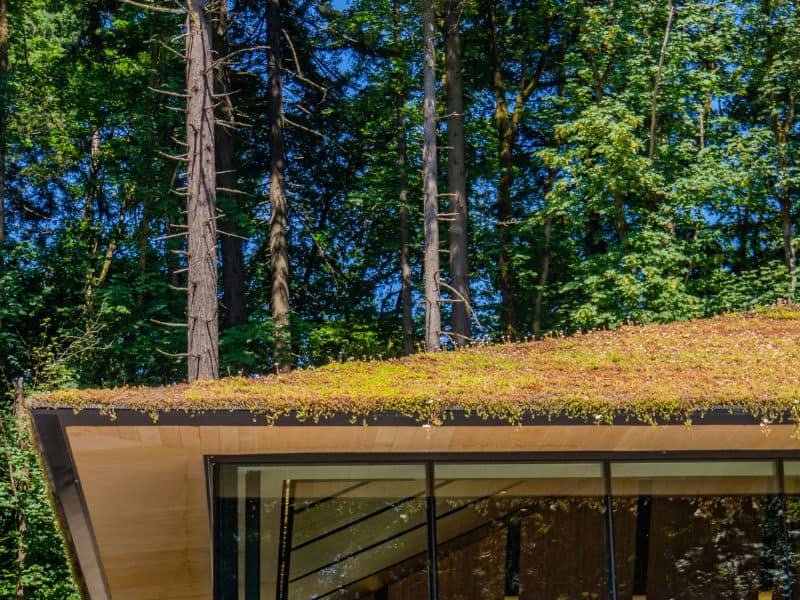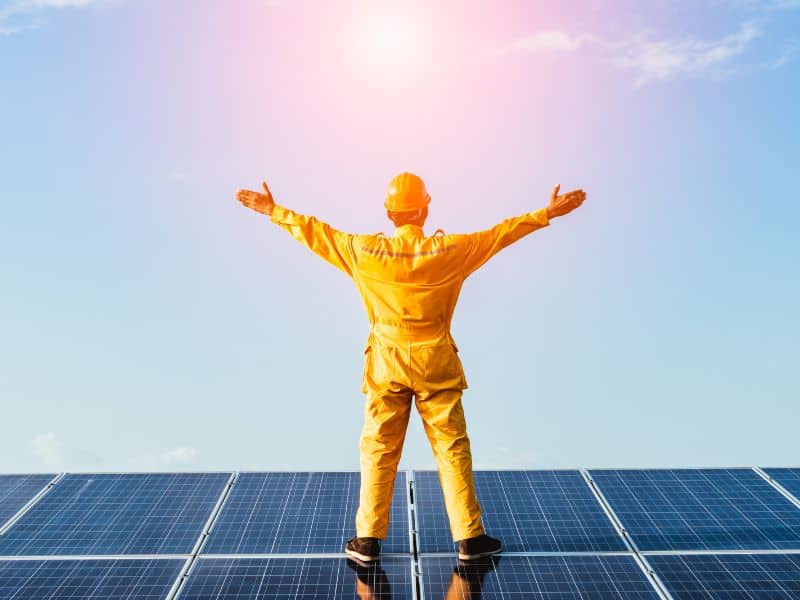What is an Eco-Building Anyway (With 7 Examples)

The building industry has incorporated new technologies and trends to benefit the environment, society, and the economy.
Eco Buildings are one of the latest developments. While the idea of creating homes and workplaces with minimal environmental footprints is not new, it’s gained newfound popularity recently.
Eco-Building is not as complex as you might think. You can create one yourself with a little research and hard work, as long as you get the basics right and are prepared to roll your sleeves up.
Without further ado, let’s answer the question, “what is an eco-building anyway?”
If you’d like to see some examples of eco-friendly materials, why not read our article “What Is An Eco-Friendly Material? (See These 11 Examples)?”
What is an Eco-Building Anyway?

An eco-building is designed and built to minimize the use of natural resources, such as water, energy, and materials. Its materials are sustainable, it has water-saving features like low-flow taps, energy-saving features like extra insulation and solar panels, and it promotes biodiversity.
An example of an Eco-Building is the Bird’s Nest Stadium in Beijing. It incorporates eco-building practices such as rainwater harvesting and solar power for lighting the structure.
Furthermore, it allows natural ventilation, thus eliminating the need to use HVAC systems.
Other notable Eco Buildings include the Bloomberg headquarters in the UK, K2 Apartments in Australia, and the Centre for Sustainable Development in Canada.
So far, I’ve given you an idea of what eco-building entails. But this is just the tip of the iceberg.
Below are seven examples of features of Eco-Buildings. Let’s take a look.
What Are the Core Eco-Building Components?

For any eco-building, there are several things that you must get right to minimize resource use, reduce waste and, at the same time, conserve the environment.
Examples of eco-building core components are as follows:
- Green roofs
- Energy-efficient windows
- Solar energy harnessing
- Environment-friendly aluminum panels
- Landscape that improves biodiversity and habitat
- Recycling systems
- Water conservation mechanisms
I’ll elaborate on each of these below, so read on.
1. Green Roofs

Having a green roof is one proven way of curtailing heat islands (a phenomenon that causes buildings to be hotter than their surroundings).
According to the EPA, lack of vegetative matter in a building’s vicinity is a leading cause of heat islands.
Green roofs are partly or completely covered in vegetation planted in a suitable growing medium and prevent sunlight from directly heating the roof’s surface. This prevents the roof from heating up as much, which helps to keep the inside of the building cooler.
In fact, it is proven that green roofs can reduce the roof’s surface temperature by about 30–40°F, which is impressive and saves a lot in cooling costs compared with running an air conditioning system, particularly in a large building.
2. Energy-Efficient Windows

A glass window’s primary role is to allow sunlight to permeate the building and thus enhance natural lighting. However, the downside of allowing sunlight through windows is unwanted heat gain. During the winter, the windows can also be a serious route for heat losses from a building.
We’ve known this for years. Here’s an interesting statistic to prove the point. In 1990, the US spent approximately $20 billion in heat regulation resulting from heat gains and losses through windows.
It’s crazy to imagine how much the country and the rest of the world spend unnecessarily on heating and cooling, with the millions of buildings that have sprung up since the above statistic was calculated adding to the total.
So what are energy-efficient windows? They are designed and made from materials that reduce heat loss and solar gain.
Heat losses will be more of a concern in colder climates, and the best windows to use will have low U-values, whereas, in hotter climates, a low solar heat gain coefficient is more important.
These properties are tested and certified by government organizations, so you can be confident in your selection. You can learn more about these certifications on the ENERGY STAR and NFRC websites.
Such a glass window features a metal oxide layer on the inside surface. Hence, it will allow light but not heat from outside while reflecting back heat inside the home.
3. Solar Energy Harnessing

Solar power is arguably the easiest form of energy to harness as its freely available. Therefore it forms a critical part of eco-buildings as it supplies power needs sustainably and cheaply.
For this reason, it is one of the most prevalent components in all eco-buildings; it’s also very clean and releases no emissions during operation. This cleanliness contrasts with other renewable energies, such as biomass and, to a lesser extent, geothermal power.
A slightly different use of solar energy, which utilizes the sun’s heat directly, solar water heaters and booths where people can access the sun without necessarily moving outside the building are common in eco-buildings.
4. Environmentally-Friendly Aluminum Panels

You may have heard aluminum referred to as the green metal, and rightly so, considering it’s almost 95% recyclable. In addition to being fully replenishable, it is also one of the most abundant metals, accounting for 8% of the earth’s crust.
In addition to these impressive stats, aluminum qualifies as a key component in eco-buildings as it’s fully weather and pest resistant and non-reactive.
It’s also lightweight, making it less expensive and energy-intensive to transport. Hence it’s arguably a better alternative to other construction materials, such as steel.
5. Landscape That Improves Biodiversity

With eco-building, there’s more than just the physical structure to consider – the outside environment matters too.
Planting trees and vegetation such as shrubs and flowers helps to improve habitat and biodiversity, as well to act as potential windbreaks and provide shade on sunny days.
Moreover, vegetation helps improve air quality by absorbing pollutants from the atmosphere and producing oxygen while creating a pleasant environment conducive to human and wildlife habitation.
6. Recycling Systems

The efficient utilization of resources is a cardinal feature of eco-building.
Recycling and waste minimization techniques are key during the construction and operation of an eco-building.
You can achieve this by carefully managing building materials inventory to prevent waste during construction and by incorporating recycling and composting facilities to minimize the amount of recyclable and biodegradable waste going to landfills once the building is occupied.
For instance, waste materials such as papers used in offices can be recycled. During construction, building debris, such as broken tiles, can be used in outdoor pavements and so on.
7. Water Conservation

Water is central to any functioning ecosystem, and eco-buildings must minimize the use of water during construction and operation.
If the structure is residential, there are conservation features, such as installing low-flow shower heads and taps. Also, setting up systems that allow greywater recycling is pertinent to this cause.
And that’s not all. An eco-building could collect and conserve rainwater to reduce reliance on freshwater taken from the natural environment.
Summary
I’ve highlighted what eco-building entails by listing some of the key features that qualify a building as “eco.”
Using all of the techniques and principles listed above in a new or renovated building should earn the title of “eco-building.”
Not only that, but it will save you money, thanks to reducing your dependence on the energy grid and cutting your water bills.
You’ll also have a much more pleasant home or work environment, promoting well-being and biodiversity.
For more information about sustainable building materials to use in your next eco-buiilding project, check out our article “23 Sustainable Building Materials You Can Use Today.”







